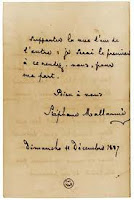
(http://en.sensemusic-shop.de/index.php?jump=order)
Bosma begins her analysis with looking at the changes that occurred in the infrastructure. She claims that although German newspapers had been writing about Techno music since its creation, many had simply regarded it as a fad. She claims that such music was hiding amongst information and mentions the term “Hiding in the Light” to describe this phenomenon (401). Although Techno was ignored by many for so long, it did not hider its development. In fact, it was a crucial part in its evolution, as it soon became a music “denied of any cultural or political relevance because it was only technology, not humanity that was expressing itself” (401).
The failure of others to commit to Techno and take it on as their own forced it to form its own base and infrastructure. While the evolution of record stores and the rising costs of resources to make a record seemed to hinder many musicians, Techno and the artists who created it seemed to benefit. Because the equipment needed to make Techno music was far cheaper than that of other musical genres, Techno artists began to profit while others struggled, and Techno music was finally recognized and given its independence.
The evolution of Techno music is still taking place today, and its numerous connections to other kinds of music and artists seems to benefit this evolution. However, “Techno still seems to be able to make its own way and uphold its own set of rules,” proving that it has finally become its own genre (401). Bosma claims that, although the 12” appeared to hinder the recognition of Techno before, it is now the secret to its success. The 12” has come to symbolize real music to many DJ’s, while the CD represents new technology, full of technical problems and reduced quality.

An example of a 12”
(http://commons.wikimedia.org/wiki/File:12_Inch_Single_BBQ_Band.jpg)
In her conclusion, Bosma address a key factor in the success of Techno. In the past, music was viewed as self-expression, and the relationship between the author and the music was very important; however, Techno has helped shift the focal point to the music itself, which in turn has benefited the evolution of Techno as a musical genre.
“Mallarmé on Fashion” by P.N. Furbank and Alex Cain

Stéphane Mallarmé
(http://www.lescorriges.com/article-2847--mallarme__poesies__brise_marine.php)
Stéphane Mallarmé, a French poet and critic, was seen by many of his fellow writers as the ‘master’ of his day. In 1874, at the suggestion of a publisher named Charles Wendelen, the acclaimed poet emerged as the editor, designer, and author of a women’s fashion magazine called Le Derniére mode. However, in order to keep his anonymity, Mallarmé’s works were all written under a variety of pseudonyms, including “Marguerite de Ponty,” “Miss Satin,” and “Ix.” Under the name “Mme de Ponty,” Mallarmé promised “to supply dress patterns and [undertook] commissions at dress-shops and emporia on behalf of readers” (5). The magazine was beautifully designed, featured intellectual pieces as well as several attractive images, and appealed to an upper-class audience. Nevertheless, few chose to take the publication seriously, with “the editors of the old Pléiade edition [regarding] it as no more than a piece of hackwork” and Rémy de Gourmont writing “a rather flimsy essay about it… Nobody [seemed] really to have grasped the extreme interest and value of the work, until Jean-Pierre Lecercle,” who went on to establish that no magazine like Mallarmé’s had ever existed before (6).

(http://maisonsecrivains.canalblog.com/archives/mallarme_stephane_/index.html)
However, Mallarmé was not the only writer of his time to theorize about fashion, and many other intellectuals tried their hand at the subject. Baudelaire wrote essays criticizing modern artists of his day for “dressing up their subjects in medieval or Renaissance or oriental costumes on the pretext that modern costume [was] hopelessly ugly,” while the “proper aim of the artist [was] to extract the beauty of the modern” (8-9). Baudelaire ignored the fact that fashion consists, “not merely of dress-design but of gesture and facial expression and manners,” and in his most famous work, “Eulogy of Make-up,” he claims that “Nature is in fact an evil tyrant” and that, in order to fight Nature, women should employ the use of make-up. In contrast to Baudelaire, Mallarmé saw no difference between Nature and art. He claimed that “nature and the man-made are not to be distinguished” (9).

(http://livrenblog.blogspot.com/2007/11/la-mode-de-mallarm.html)
Although there were others who wrote on fashion, “what Mallarmé did was unique. He made himself, in all seriousness, a fashion designer, and at the same time a parody of a fashion journalist… this opened up to him possibilities not available to the mere critic or theorist, like… Baudelaire” (10). Mallarmé was able to explore fashion from the inside and use his publication to express his vision that extended far beyond clothes. However, Mallarmé did not escape criticism, with people such as Roger Dragonetti denying “Mallarmé could have ever been interested in fashion” (12). Dragonetti even went as far as to say that “La Derniére mode never actually existed in the full sense: it was a piece of private publication for the eyes of a group of friends” (12). However, evidence of the publication does exist, making Mallarmé the creator of the first fashion publication.

No comments:
Post a Comment